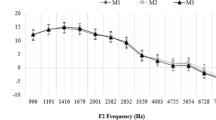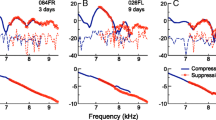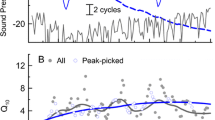Abstract
Objective: The purpose of this study was to collect parametric measures of TEOAEs in normal hearing children of various age-groups and to establish a normative baseline for Transient Evoked Otoacoustic Emissions (TEOAEs).Methods: Sixty subjects were investigated in three age-groups: neonates, 0–1 month; infants, 1 month-1 year; and children, 1–6 years. Each group comprised of 20 subjects. All the subjects underwent medical examination by a pediatrician and an ENT surgeon. Screening for hearing was done by immittance testing, behavior observation and conditioned play audiometry. The TEOAEs were analyzed for the parameters of amplitude, cross-correlation (wave reproducibility) and signal-to-noise ratio (SNR).Results: There was no difference between the mean amplitudes of the right and left ears in the groups. The females in the neonates group had higher emission amplitudes than the males. The mean amplitude of the subjects in the neonates group was significantly higher than the subjects in the infants, or children groups. The cross correlation (wave reproducibility) was constant across the age. The mean SNR for all the subjects were well above 3 dB at frequencies 1.5 k, 2k, 3k and 4kHz. The neonates group showed the lowest SNR ranging between 3.47 to 9.62 dB. The infants group showed the highest SNR ranging between 6.13 to 13.11 dB.Conclusion: The TEOAEs response measures of SNR and cross correlation, at frequency bands 1.5, 2, 3 and 4 kHz, may provide more reliable outcomes than TEOAEs amplitude. Subjects in the age range of 0–1 month show lower SNRs than those in higher age ranges. The values can be used as normative data for screening and diagnostic purposes in the pediatric population.
Similar content being viewed by others
References
Kemp DT. Stimulated acoustic emissions from within the human auditory system.J Acoust Soc Am 1978; 64: 1386–1391.
Kemp DT. Otoacoustic emissions in perspective. In Robinette MS, Glattke TJ, Eds.Otoacoustic Emissions: Clinical Applications. New York: Thieme, 1997: 1–21.
Glattke TJ, Robinette MS. Transient evoked otoacoustic emissions. In Robinette MS, Glattke TJ, Eds.Otoacoustic emissions: Clinical applications. New York: Thieme 1997: 63–82.
Collet L, Maulin A, Gartner M and Morgan A. Age related change in evoked OAEs.Ann Oto Rhino Laryngol 1990; 99(12): 993–997.
Aidan D, Avan P, Bonfils P. Auditory screening in neonates by means of transient evoked otoacoustic emissions: A report of 2,842 recordings.Ann Oto Rhino Laryngol 1999; 108: 525–530.
Kok MR, van Zanten GA, Brocaar MP. Growth of evoked otoacoustic emissions during the first days post-partum: a preliminary report.Audiol 1992; 5: 140–149.
Norton SJ, Widen JE. Evoked otoacoustic emissions in normal hearing infants and children.Ear Hear, 1990; 11: 121–127.
Elberling C, Parbo J, Johnsen NJ and Bagi P. Evoked acoustic emissions: Clinical application.Acta Otolaryngol 1985; 421: 77–85.
Richardson MP, Williamson TJ, Lenton SW, Tarlow MJ, Rudd PT. Otoacoustic emissions as a screening test for hearing impairment in children.Arch Dis Child 1995; 72: 294–297.
Kon K, Inagaki M, Kaga M. Developmental changes of distortion product and transient evoked otoacoustic emissions in different age groups.Brain Dev 2000; 22(1): 41–46.
Norton SJ, Gorga MP, Widen JE, Folsom RC, Sininger Y, Cone-Wesson B, Vohr BR, Fletcher KA. Identification of neonatal hearing impairment: Evaluation of transient evoked otoacoustic emission, distortion product emission, and auditory brain stem response test performance.Ear Hear 2000; 21: 508–528.
Harrison WA, Norton SJ. Characteristics of transient evoked otoacoustic emissions in normal hearing and hearing impaired children.Ear Hear 1999; 20: 75–86.
Brass D, Kemp DT. The objective assessment of transient evoked otoacoustic emissions in neonates.Ear Hear 1994; 15: 371–377.
Brass D, Watkins P, Kemp DT. Assessment of an implementation of a narrow band, neonatal otoacoustic emission screening method.Ear Hear 1994; 15: 467–475.
Dirckx JJJ, Daemers TH, Somers F, Offeciers FE, Govaerts PJ. Numerical assessment of TOAE screening results: currently used criteria and their effect on TOAE prevalence figures.Acta Otolayngol 1996; 116: 672–679.
Author information
Authors and Affiliations
Corresponding author
Rights and permissions
About this article
Cite this article
Kapoor, R., Panda, N.K. Transient evoked otoacoustic emissions. Indian J Pediatr 73, 283–286 (2006). https://doi.org/10.1007/BF02825819
Issue Date:
DOI: https://doi.org/10.1007/BF02825819




